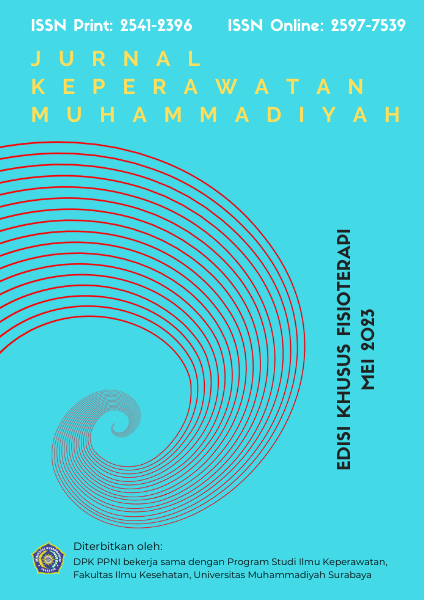Pengaruh Pemberian Pelvic Floor Exercise TerhadapEnuresis Pada Anak Pre-Sekolah (Di Sekolah Luar Biasa Negeri Gedangan Sidoarjo)
DOI:
https://doi.org/10.30651/jkm.v0i0.16335Keywords:
Enuresis, Bladder Diary, Pelvic Floor ExerciseAbstract
: Enuresis is bedwetting behavior that occurs in children aged at least 5 years or more which is caused by delays in the development of the urinary organs and supported by weakness of the pelvic floor muscles which eventually causes children to have bed wetting behavior during the day or especially at night. Â Pelvic Floor Exercise is a pelvic floor muscle exercise which is quite common and is widely used in cases of incontinence, whereby activating the pelvic floor muscles isometrically and its muscle control is expected to increase sensorimotor so that it has an impact on the appearance of a feeling when the bladder response is full and holding it for a while so it doesn't automatically proceeds to the excretion process of urination.
Methods: Â The design of this study uses pre-experimental. The type of research is one group pretest posttest. In this study, it was started by conducting interviews with parents and explaining filling in the Bladder Diary sheet which is useful for knowing the frequency of enuresis in children. The study was conducted with 15 respondents, giving pelvic floor exercise 2 times a week within 8 weeks.
Results:  Showing the result of the significance value of the Paired Sample T Test is 0.000<α (α= 0.005), then there is an effect of giving Pelvic Floor Exercise on changes in Bladder Diary results
Conclusion: There is an effect after giving the Pelvic Floor Exercise to the frequency of enuresis in pre-school-aged children at the SLB Negeri Gedangan Sidoarjo, with a Paired T-Test significance of 0.000 < α (α = 0.05). Where with these results it can be reduced to eliminate the habit of wetting the bed at night in children.References
American Psychiatric Association (2013) DSM-5. United States of America: American Psychiatric Publishing.
Baird, D.C. et al. (2018) ‘Enuresis in Children: A Case-Based Approach’.
Caldwell, P.H.Y. et al. (2018) ‘Bedwetting and toileting problems in children’, Medical Journal of Australia, 182(4), pp. 190–195. Available at: https://doi.org/10.5694/j.1326-5377.2005.tb06653.x.
Campos, R.M. et al. (2019) ‘Pelvic floor muscle training alone or in combination with oxybutynin in treatment of nonmonosymptomatic enuresis. A randomized controlled trial with 2-year follow up’, Einstein (Sao Paulo, Brazil), 17(3), p. eAO4602. Available at: https://doi.org/10.31744/einstein_journal/2019AO4602.
Cortes, G.A. and Flores, J.L. (2022) ‘Physiology , Urination’, pp. 10–12.
Eickmeyer, S.M. (2017) ‘Anatomy and Physiology of the Pelvic Floor’, Physical Medicine and Rehabilitation Clinics of North America, 28(3), pp. 455–460. Available at: https://doi.org/10.1016/j.pmr.2017.03.003.
Fitricilia, M., Umboh, A. and Kaunang, D. (2013) ‘Hubungan Enuresis Dengan Infeksi Saluran Kemih Pada Anak Usia 6-8 Tahun Di Sd Negeri Malalayang’, Jurnal e-Biomedik, 1(1). Available at: https://doi.org/10.35790/ebm.1.1.2013.4582.
Fornari, A. and Carboni, C. (2018) ‘Classic papers on pelvic floor physiotherapy: the most frequently cited articles in three decades (1983–2013)’, International Urogynecology Journal, 29(10), pp. 1429–1433. Available at: https://doi.org/10.1007/s00192-018-3573-y.
Fuentes, M., Magalhães, J. and Barroso, U. (2019) ‘Diagnosis and management of bladder dysfunction in neurologically normal children’, Frontiers in Pediatrics, 7(JULY), pp. 1–11. Available at: https://doi.org/10.3389/fped.2019.00298.
Garcia-Fernandez, A. and Petros, P.E. (2020) ‘A four month squatting-based pelvic exercise regime cures day/night enuresis and bowel dysfunction in children aged 7–11 years’, Central European Journal of Urology, 73(3), pp. 307–314. Available at: https://doi.org/10.5173/ceju.2020.0044.
von Gontard, A. (2019) ‘Diagnose und Behandlung der Enuresis und der funktionellen Harninkontinenz tagsüber’, Deutsches Arzteblatt International, 116(16), pp. 279–285. Available at: https://doi.org/10.3238/arztebl.2019.0279.
Hidayat, A. (2014) Metode Penelitian Kebidanan dan Teknik Analisis Data: Contoh Aplikasi Studi Kasus. Jakarta: Salemba Medika.
Nevéus, T. et al. (2020) ‘Management and treatment of nocturnal enuresis—an updated standardization document from the International Children’s Continence Society’, Journal of Pediatric Urology, 16(1), pp. 10–19. Available at: https://doi.org/10.1016/j.jpurol.2019.12.020.
Nieuwhof-Leppink, A.J. et al. (2021) ‘Definitions, indications and practice of urotherapy in children and adolescents: - A standardization document of the International Children’s Continence Society (ICCS)’, Journal of Pediatric Urology, 17(2), pp. 172–181. Available at: https://doi.org/10.1016/j.jpurol.2020.11.006.
Notoatmodjo (2018) Metodologi Penelitian Kesehatan. Jakarta: Rineka Cipta.
Othman, J.A.M. et al. (2021) ‘Childhood nocturnal enuresis—a marker for pelvic floor disorders and urinary tract symptoms in women?’, International Urogynecology Journal, 32(2), pp. 359–365. Available at: https://doi.org/10.1007/s00192-020-04345-x.
Permatasari, R.C., Perdani, R.R.W. and Bustomi, E.C. (2018) ‘Diagnosis dan Tatalaksana Enuresis Pediatri’, Medical Journal Of Lampung University, 7(2), pp. 283–287.
Rahardjo, H.E. (2020) ‘Indonesian Urologists’ Current Practice on Nocturnal Enuresis’, eJournal Kedokteran Indonesia, 8(1). Available at: https://doi.org/10.23886/ejki.8.11687.
Rincon, M.G. et al. (2022) ‘Nocturnal Enuresis’, pp. 2–7.
Rossetti, S.R. (2016) ‘Functional anatomy of pelvic floor’, Archivio Italiano di Urologia e Andrologia, 88(1), pp. 28–37. Available at: https://doi.org/10.4081/aiua.2016.1.28.
Schreiner, L. et al. (2018) ‘Systematic review of pelvic floor interventions during pregnancy’, International Journal of Gynecology and Obstetrics, 143(1), pp. 10–18. Available at: https://doi.org/10.1002/ijgo.12513.
Soemyarso, N.A. (2017) Ngompol pada Anak, Ikatan Dokter Anak Indonesia. Available at: https://www.idai.or.id/artikel/seputar-kesehatan-anak/ngompol-pada-anak.
Wahyuriko, P.E. (2020) ‘Terapi Perilaku untuk meningkatkan perilaku asertif pada anak dengan gangguan enuresis’, Procedia : Studi Kasus dan Intervensi Psikologi, 8(3), pp. 101–111. Available at: https://doi.org/10.22219/procedia.v8i3.14308.
Woodley, S.J. et al. (2020) ‘Pelvic floor muscle training for preventing and treating urinary and faecal incontinence in antenatal and postnatal women’, Cochrane Database of Systematic Reviews, 2020(5). Available at: https://doi.org/10.1002/14651858.CD007471.pub4.
Downloads
Published
Issue
Section
License
- Penulis tetap memegang hak atas karyanya dan memberikan hak publikasi pertama kepada jurnal ini yang secara simultan karya tersebut dilisensikan di bawah:Â Creative Commons Attribution-ShareAlike 4.0 International (CC BY-SA 4.0)













